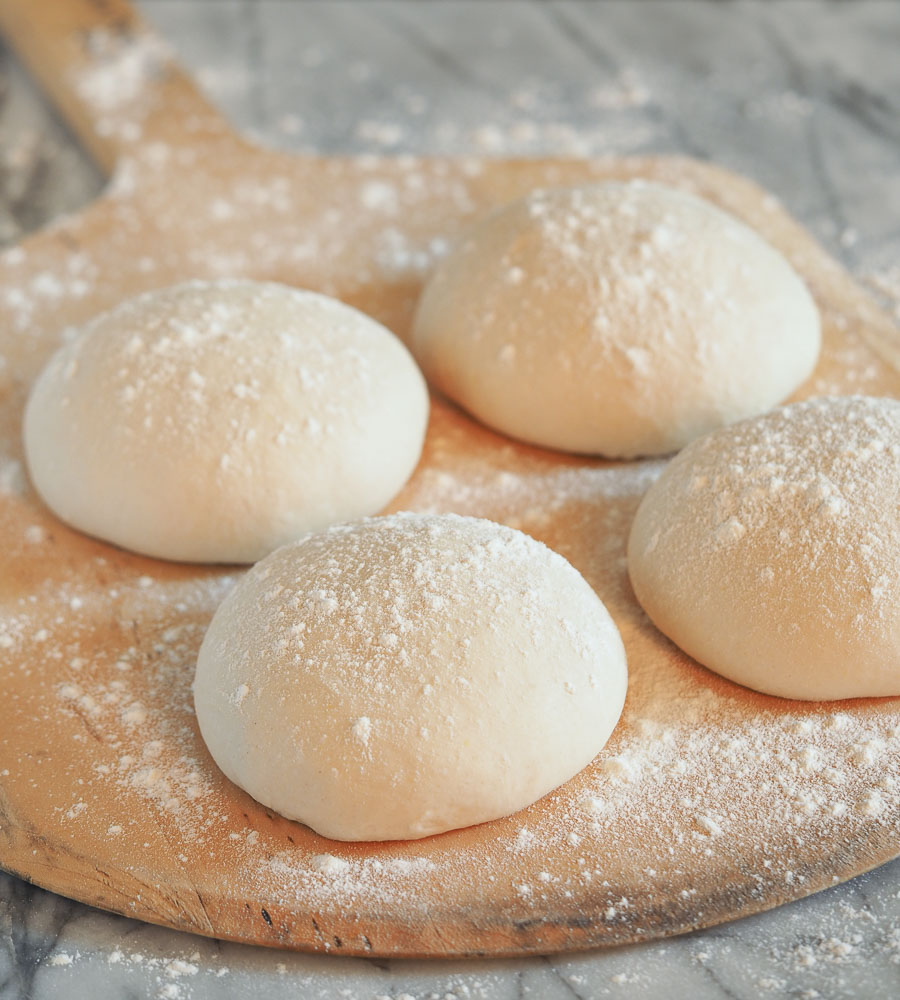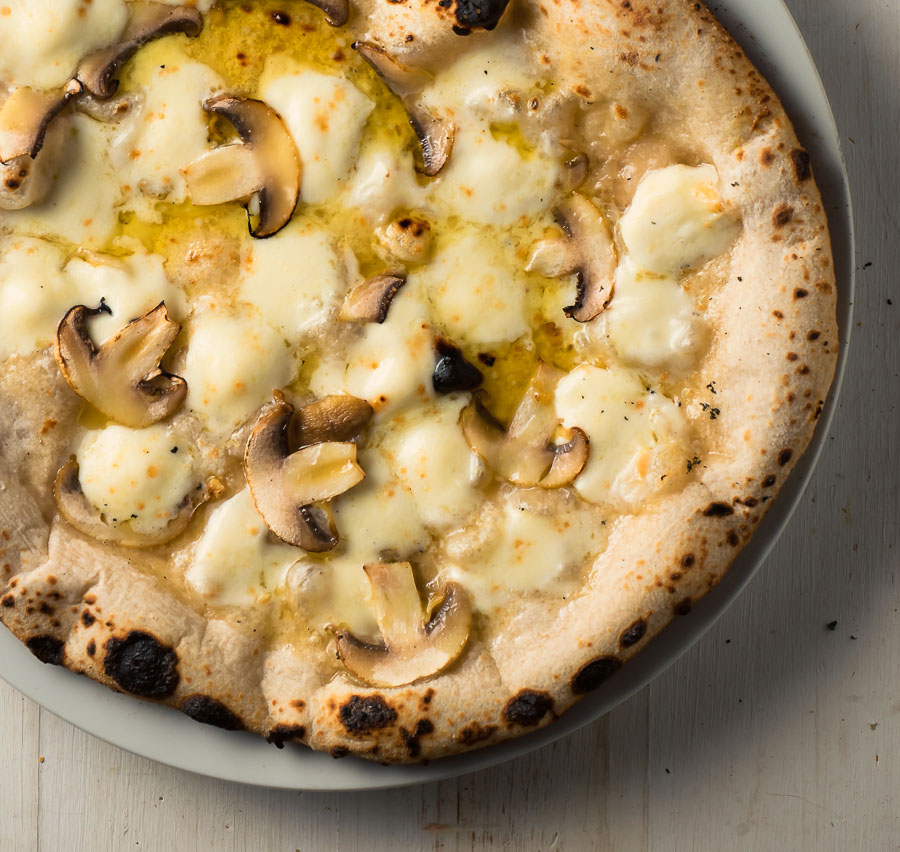Neapolitan pizza is a magical thing. The crust has a tang. Real flavour. Not that drab, everybody eats around it stuff.
And it starts with the dough. This isn’t your everyday pizza dough. Get this right and you will make better pizza than you can buy. For real.
If you want to learn about Neapolitan pizza read this post. Don’t skip to the recipe. This is not about anything except making pizza dough.
2500 words on pizza dough. Nothing else. Look at the crust on the pizzas in this post. That’s what I’m talking about…
Every pizza dough recipe out there goes something like this. Mix up some flour, water, way too much yeast, salt, oil and sugar. Proof it for a few hours. Ball it up. Make pizza.
It works. Sort of. There’s something there holding the toppings up. But it’s bland. Simple. Usually pretty dry. Not that good. Nowhere near that magical Neapolitan pizza crust.
Think I’m crazy? What can there possibly be to pizza dough? Something delicious. Something special. That’s what.
This is really, really good dough
Don’t believe me? Think about that wonderful bread you get at an artisan bakery. The depth of flavour. The texture. Now think of Wonder bread. That’s the difference I’m talking about. This is about artisan.
It isn’t really hard to make Neapolitan pizza dough. It is going to seem a bit daunting at first. I’m doing my best to explain it here.
It took me a full year to figure all this out. Maybe more. I don’t know how many pizzas I screwed up. A lot. Don’t feel bad for me though. Screwed up Neapolitan pizza is still pretty amazing.
This is a long read. The summary of a year’s work. Follow me down the rabbit hole. It’s fun. And the results are sooo worth it. I’m asking a lot here. But if you are serious about making the best pizza you have ever had read on.

The stuff you need to make Neapolitan pizza
The oven
Before you get too far understand that Neapolitan pizza is cooked with high heat. That’s a pre-requisite. You need an oven that gets hot to make Neapolitan pizza.
Your kitchen oven can’t do it. Your BBQ might be able to do it. You will need some gear to make this happen.
Luckily it’s becoming a thing. There’s the Blackstone. The Ooni. The BakerStone pizza oven works with your BBQ.
The days of needing a wood burning oven are behind us. They are still super cool. I still want one. But you don’t need it to make Neapolitan pizzas.
What doesn’t work is a pizza stone. Neapolitan pizza relies on refractory heat. That’s a fancy way of saying it needs heat from above as well as below.
Neapolitan pizzas cook in the 750F to 900F range. They cook in under two minutes. 90 seconds from the time the pizza hits the oven to dinner. For real.
Try to cook a pizza on a stone at 900F on your BBQ. You get one seriously burnt pizza. Or raw dough on top. There’s no in-between. I tried to make BBQ pizza work for a long time. I gave up.
You need an oven that makes pizza. The nice thing is now they are in the hundreds of dollars. Not the thousands like they used to be.
And you can use that oven for other things. Want to make naan bread? Sear a steak at 800F? Roast vegetables at high temp? The best nachos you have ever had? All possible with the right oven.

Measure your ingredients – by weight
You are going to need a scale. Actually you will need two scales. Or a really good one. You probably have one that measures to 1 gram accuracy. That’s good. But you are going to need a second scale.
The second one will need to measure to 1/100 of a gram. That covers you if you want to use instant dry yeast. If you are using a sourdough starter 1/10 of gram is fine.
Took me forever to figure out where to buy the second scale. I saw them online for hundreds. Medical scales. Too rich for me. Turns out drug dealers need scales that measure 1/100 grams.
And they don’t want to spend hundreds of dollars. Go to a smoke shop. That’s where I got mine. Cheap. But it works just fine.
The other bits
You will need a pizza paddle. One that’s big enough. Mine is 14 inches. Works well. A small second paddle you can use to move your pizza around as it cooks is helpful too.
You will need an infrared thermometer that goes up to 900F+. These aren’t expensive. And they are super useful.
You can use them to measure the room temperature where you will be proofing the dough. That’s really important. You can use it to measure your pizza oven temperature.
That’s really important too. And you can use it with your regular oven. Way more accurate than the knob on the front. Great for baking.
A stand mixer is the last bit of gear you need. By stand mixer I mean a Kitchen-Aid or Hobart mixer or equivalent. I do not mean a food processor. A dough hook for your mixer is very nice to have. Think about getting one.
You could try to do it by hand but that would be real work. I’ve never even tried. If you know what you’re doing though, by hand is definitely an option.
Flour, water, salt and yeast
There are only 4 ingredients in Neapolitan Pizza Dough. That’s all. No secret ingredients. No sugar. Or oil. None of that. Those are the rules. Not my rules.
The rules set out by the Associazione Verace Pizza Napoletana. Seriously. Four ingredients. It’s mind blowing what you can do with those 4 ingredients.
The water and salt don’t matter too much. But the flour has to be 0 or 00. All purpose won’t work. At 800F all purpose flour burns. Badly. Don’t try it. Any decent Italian grocer will have pizza flour.
I like Molina Caputo 00 in the blue bag. My favourite. But there are lots of choices. Just make sure it says 0 or 00.
I use a live sourdough starter. A sourdough starter from Ischia in Naples in fact. Just to give you an idea of how crazy I am. But any good sourdough starter culture will work.
If you are into making sourdough bread your starter is perfect. If you have no idea what I’m talking about google it. Sourdough starter. There is a ton of information on it. Worth considering as you get into making Neapolitan pizza.
Instant dry yeast works as well. But it takes so little instant dry yeast to do this that you need a scale that goes down to 1/100 of a gram.
You are going to be measuring a few granules of yeast. Literally. First time I did it I didn’t believe it was even possible. But it is.

Time and temperature – the other two ingredients
Time and temperature are the other two ingredients. Key variables in the process. Yeast ferments at different rates depending on the temperature.
Colder temperatures. Slower fermentation. Higher temperatures. Faster fermentation. So if time is fixed colder temperatures need more yeast. For higher temperatures less yeast is needed. That’s all you really need to know.
A sourdough starter has bacteria in it as well as yeast. The bacteria are what makes sourdough sour. And that’s why it takes so long to make this pizza dough. The bacteria work slower than the yeast. Takes more time for them to add that sour tang.
The same bacteria are present in the air. You get the same effect if you are using instant dry yeast. Might not be quite as good as sourdough. But it is close enough to impress the hell out of everybody who tries your pizza.
I’ve tried to make dough in 24 hours. It worked. I made pizza. It puffed up. Looked perfect. But it didn’t have the flavour. No depth.
It takes 48 hours to really get the balance of properly risen dough and that wonderful sourdough tang.
So figure out what room temperature is where you will let the dough sit. And then use the table below to figure out how much starter or instant dry yeast you will need.
A lot of complicated concepts here but the formula works. You don’t need to understand it. But you do need to follow it.
How much yeast for Neapolitan pizza dough?
It will amaze you how little yeast you need. You won’t believe it at first. Nobody does. But it will work. Have faith.
Slow fermentation. That’s the key to complexity and flavour. Give it the time it needs to work it’s magic. A little bit of yeast. A long time. That’s the secret.
The table gives you the right amount of yeast. Cellar temperature range. If you can’t get into the range because your house is too hot try using a cooler with a frozen water bottle.
I’ve done that. It works. If you try to go much above 70F it gets very, very hard to measure out your yeast accurately.
| Temperature (Farenheit) | Sourdough Starter (grams) | Instant Dry Yeast (grams) |
| 64 | 5.6 | 0.07 |
| 65 | 3.9 | 0.07 |
| 66 | 2.7 | 0.07 |
| 67 | 1.8 | 0.06 |
| 68 | 1.2 | 0.05 |
| 69 | 0.7 | 0.05 |
| 70 | 0.5 | 0.04 |

The workflow for Neapolitan pizza dough
I have a workflow that works for me. Yours might wind up a little different. But this is a good starting point. The important thing is to get your workflow figured out and stick to it. I use a timer to keep myself on track.
If you are using a starter take it out the fridge the night before you are going to make dough. Let it warm up.
In the morning feed your starter. Leave it out on the counter to really get going. Using instant dry yeast? Ignore this step.
Put a bottle of water in the fridge. You will want your water at about 40F. Go to work. Or do what you need to do. Enjoy your day.
Mix the dough
About 48 hours before you plan to eat pizza get ready to make Neapolitan pizza dough.
Measure out your ingredients. Pull out your stand mixer. By stand mixer I mean a Kitchen-Aid or Hobart mixer or equivalent. I do not mean a food processor.
Put the water in the mixer bowl. Add the salt. Stir to dissolve the salt in the water. Add around 2/3 of the flour and mix it with the water. Add your starter.
It’s a little different if you are using instant yeast. Salt kills yeast. So add 2/3 of your flour and the dry yeast to the water. Mix it up. Sprinkle your salt on top.
From here on in it’s the same for sourdough starter and dry yeast. Set a timer for 6 minutes. Start your mixer on it’s lowest speed. Let it go about a minute.
Add the rest of the flour over the next minute or so. Let the mixer do it’s magic for the next 4 minutes. At the end of the six minutes it should look like a ball of dough. A bit ragged maybe, but a cohesive ball.
If it doesn’t, turn the mixer up one setting and let it go until it does. Shouldn’t take more than another minute. You don’t want to overwork the dough.
Knead the dough
Transfer the dough to the counter. Knead it 27 times. Not 26 and not 28 and certainly not 29. That will ruin it.
No. Not really. This isn’t chemistry class. Knead it 25-30 times. Rotate the dough every 5 kneads or so. Cover it with a bowl and set your timer for 12 minutes.
The slap and fold
After 12 minutes pick up the dough and give it 3 slap and folds.
Are you wondering what I’m talking about? Slap and fold? This one took me quite a while to figure out. A slap and fold is just what it sounds like. Take the dough by one side.
Now try to hit the back of the counter with the other side of the dough without letting it go. Beat the dough down on the counter but don’t let go. Womp. You are trying to get the dough to extend as long as it will go. That’s the slap.
Now take this now long piece of dough and fold it onto itself to halve the length. That’s the fold.
Do this two more times. You will feel the dough tighten. Your third slap will hardly extend the dough at all.
Cover the dough again and set your timer for 12 minutes. The dough is resting.
When the timer goes off repeat the slap and folds a second time. If the dough doesn’t look pretty smooth after the second slap and fold let it rest another 12 minutes.
Then repeat the slap and folds a third time. Now you have Neapolitan pizza dough that’s ready to start to ferment.

Neapolitan pizza dough rests for 24 hours
Yes. 24 hours. Plus or minus. 22 hours is OK. 25 is too. The error bars are pretty big here. They call this part the bulk ferment.
Place the dough ball in a round Tupperware and cover it loosely with the lid. Set it aside for 24 hours. Put it in the spot where you figured out what the temperature was going to be for the whole process.
Remember that Neapolitan pizza dough fermentation is a function of time and temperature. Once you commit to a temperature you kind of need to stick to it…
Ball your dough
After 24 hours it’s time to ball the dough. Portion it out into pizza sized balls. I aim for 307 gram balls. Just works that way with the quantities specified. I use a scale to get it right.
The goal is to get the skin of the dough pulled tight over the ball. I can’t describe it well enough with words.
I think Youtube is your best bet here. You have to see it to understand. It’s a visual thing. Search for “how to ball pizza dough”.
I use a 6 inch round Tupperware to ball ferment the dough once it’s balled. I do this because it makes it easier to open the dough when it’s time to cook.
Tried 4 inch Tupperware containers first. My life got a lot better when I switched. Trust me.
Spray a little oil into the containers. Add your balled dough. The oil just makes things easier. The last thing you want is to be fighting to get your dough out of the Tupperware.
Cover it loosely with the Tupperware lid and put it back in the spot and let it sit for another 24 hours. Told you it takes time…
Open your Neapolitan pizza dough
Don’t roll Neapolitan pizza dough. Just don’t. Open it. Want that big, beautiful, puffy crust? Rolling it pushes all the air out of the edge. That’s a sure-fire way to get a flat pizza. A dense pizza. Not a beautiful Neapolitan pizza.
Watch Youtube. Look for videos where they are pushing the middle of the dough to flatten it. But protecting the edge. Never compressing the outer rim. That’s key.
That’s it. You are ready to make pizza. Top your pizza lightly and cook it in your fancy new pizza oven.
My guess – it will take you a couple tries to get this down. A few more to get the feel of cooking pizzas in 90 seconds. And a lifetime of tweaking and improving.
It is work to make Neapolitan pizza right. But the payoff is worth all of it. When you nail it you will get used to people telling you that you make the best pizza ever. The best they have ever had.
I’ve been told better than some in Italy. That’s how good real Neapolitan pizza dough is.
Now you have some dough try making a classic margherita pizza.
neapolitan pizza dough
Ingredients
- 369 grams Italian 0 or 00 flour – I like Molina Caputo
- 236 grams water
- 10 grams salt
- Sourdough starter or dry yeast – quantity from the table in the post above.
Instructions
- Feed your starter if using. Put a bottle of water in the fridge. Go away for 8 hours or so.
- Measure out your flour, water, salt and yeast. You need a scale to do this. Cups and tablespoons are way too imprecise.
Using a sourdough starter
- Add the water and salt to the mixing bowl of your stand mixer. Add roughly 2/3 of the flour and mix manually.
- Add the starter to the wet mixture.
Using instant dry yeast
- Add the water to the bowl. Add 2/3 of the flour and the dry yeast and mix manually.
- Add the salt.
Make the dough
- Turn your stand mixer on to it’s lowest setting. Mix for about a minute and a half. Add the remaining flour.
- Continue mixing until the timer goes off (six minutes). Look at your dough. If it’s one cohesive ball, it’s good to go. If not, run your mixer for another minute or so.
- Remove the dough from the mixing bowl. Knead manually 25-30 times.
- Cover and let rest for 12 minutes. Use a timer.
- After 12 minutes, do 2-3 slap and folds. That’s described in the text above.
- Cover and let rest another 12 minutes or so. Set a timer so you don’t forget.
- After 12 minutes, repeat the slap and fold. Put the entire dough ball into a Tupperware. Store the dough in the room you used to measure the temperature and decide how much yeast you need. Let the dough sit for around 24 hours.
- After 24 hours ball the dough. Use your scale to help you divide the dough. I shoot for around 307 grams.
- Place it into round Tupperware containers. Let sit another 24 hours.
- When you are ready to cook, open the dough. Dress the pizza to your taste. Cook the pizza at 750F or so for around 90 seconds. Pay attention. At these temperatures things can go very wrong, very fast.




I’ve built a pizza oven this year and have used multiple dough recipes but this is a cut above the rest. Yes it takes more time and I’d say the dough is definitely harder to get on the peel it’s incredibly elastic (maybe my house is slightly warmer than I predicted and it proofed faster than expected for the amount of yeast from the table ) but the results were amazing! Definitely going to be using this recipe again. My dough rised to the point where it was pushing the cling film off the top of the bowl but in the 30mins to an hour before the oven was up to 450 it started to collapse might this be why it was really hard to handle ?
That is 450C I assume? I tend to watch the bottom of my dough ball. When I get to the point where I am liking the bubble structure I see I decide whether I can fire it in time. If not, I will put it in the fridge to slow it down a bit. If it’s a bit behind what I want I use an oven with just the light on to warm it slightly.
This is all about feel ultimately. As you work with this dough more you will start to know it and make corrections as needed.
Hey there! I gave this a go tonight with my new Roccbox and surprise it didn’t turn out perfect! Like you said it’ll take a few times to figure things out. I do appreciate the thorough instructions. What I did notice is that my crust seemed thicker/denser than desired. Before I start in on round two I was wondering if you had any thoughts on what may be the cause. Over proof? Too much yeast? Any ideas would be appreciated. Thanks!
Hard to say. Over-fermented usually results in a stickier dough that’s harder to open. There are more variables than the dough. The cook is as important. The launch. Deck temperature. Timing. All these things figure into the perfect Neapolitan pizza. It always amazes me how something so simple can be so complicated…
my wine cellar averages about 59 degrees Fahrenheit.. is there a way to get the yeast/starter table for lower temperatures or is that too cold for proofing? I don’t have a great consistent temp in any other room.
At 59 degrees you would need about 25 grams of starter. I don’t have numbers for yeast I am afraid. That’s pretty cold though. You will have to watch it. If it’s under fermenting, I’d pull it at around a couple hours to cook time and possibly place it in an oven with the light on (nothing else on) and the door closed.
If it’s trending towards over fermenting slow it down in the fridge. You are actually lucky to have a guaranteed 59 degree environment. Once you get your starter dialled in you will enjoy easy, consistent results.
Hi, such a passionate and informative article. I’m going in on 24-hour ferment at 19 degrees C average temp. So I’ll double your dry yeast quantity. Next weekend I’ll try the 48-hour process, when time allows.
The Order of Pizza Passion!
I’m not sure that doubling the yeast for a 24 hour ferment is going to necessarily work perfectly so watch your ferment and adjust as needed (warmer/colder). Certainly the flavours won’t be there as fast ferments don’t have time to develop the complexity of flavour.
Thanks for the recipe. I’ve tried it a couple of times now, once for a 2 pizza portion and once for a 6 pizza portion(3x ingredients). The 6 pizza portion, I ended up freezing after the 48 hours as the weather had turned and I had to put cooking on hold. The following day, I took the dough balls out of the freezer a couple of hours before I was ready to cook and they defrosted perfectly, but they didn’t taste as good as the first time around. I’m not sure if it was the freezing or the fact that I made 6 at a time that effected the results (or potentially the yeast). Any thoughts?
As delicious as it is to eat fresh, there are times when I’ll get an unexpected drop in from friends and want to fire up the oven on a whim and have great pizza ready to go, so having frozen dough that works as well as fresh or very close to it would be awesome.
As for the first try on the recipe, it was very tasty for sure but I don’t think I nailed it either. Will be trying that out again soon once the rain decides to stop!
I am using yeast and finding it difficult to get right, which could also be the issue. I have 2 scales that are rated to measure .01g but when I put them side by side they both vary in the read out for the same portion placed on top. Sometimes one is more than the other and vice versa. Going by what you said in the article about using literally a few granules, I think I could be getting it wrong, I wonder could you please add a photo of the portion of granules on the scale so we could get a reference as to what that might look like? I know at the very least it would tell me if my scales are bad or not, haha!
Many thanks
Have a look around the site. I cook a lot of different styles and I can say, without a doubt, that Neapolitan pizza is the most challenging thing I have ever learned to make. I’ve tried to capture a decade worth of learning in this post to save people trying having to try to figure everything out like I did. But at the end of the day it is a guideline. You are going to have to work at this I am afraid. It doesn’t just come for free. There is feel involved here.
One trick I used to help develop a better understanding of what I was doing was to take pictures of the dough/bubble structure from below (use a clear Tupperware to ball your dough). I kept the pictures of the batches that worked and tried to adjust accordingly.
Small variations in temperature over 48 hours makes a surprising difference. Sometimes I’ll put the dough in the fridge to slow things down in the last few hours. Other times I’ll put it in an oven with just the light on to speed things up. Or I’ll even delay dinner by an hour or two. These are the things you will start to be able to do as you get more experience.
As far as your 6 ball batch goes, bigger batches tend to make it easier to weigh out the yeast accurately so they typically work better. I suspect freezing is what caused the problem. I’ve never even tried to freeze Neapolitan dough.
I don’t think a picture of the number of granules of yeast is going to help. My yeast could be different from your yeast. The relative humidity where you store your yeast could also affect the measurement. Getting a feel of how the dough looks to manage the effects of time and temperature in your ferment is more important IMO.
I still mess up after 10 years. In my experience there’s no nailing it every time. You just get to the point where you are more likely to nail it. If you can get to 90 percent nailed and 10 percent not quite there I’d say you were a master. I’ve been to Neapolitan pizzerias in the US where they ferment their dough in a special temperature and humidity controlled room. That’s how much of a difference slight variations can make. And that’s why developing feel is so important. You can’t control everything. You have to learn to adapt.
I’m not trying to discourage you here. Quite the opposite. I am hoping you understand that this isn’t easy. It is totally worth it. But not easy. A challenge.
You have truly made a great recipe for Neopolitan pizza!
2 websites I’ve found that help include a yeast conversion table:
https://www.dovesfarm.co.uk/hints-tips/cheat-sheets/yeast-conversion-table
And, I also use a pizza calculator that aids in finding different hydration levels:
https://www.stadlermade.com/pizza-dough-calculator/
I’ve become partial to 65% hydration and a 200 gram pizza ball.
I really appreciate your love and dedication for the perfect pizza.
Thank you!
Thanks for the tips!
For the sourdough starter chart, is that the amount of starter per quantity (1) or (2) pizzas?
The starter is lined up with the quantities in the recipe. The recipe is for 2 pizzas worth of dough.
Thank you for the meticulous detail in the recipe.
I’m having difficulty measuring out my Sourdough accurately due to the consistency of the starter. It’s at 50% hydration but whenever I measure the exact weight onto a
plate it’s difficult to subsequently transfer the exact amount of starter into the dough without wastage.
Am I missing something? How can I get my exact measurement without leaving any residual on the spoon/plate used to transfer?
One trick I have heard of but have never tried myself is to try to float your starter in a bit of the water you will be using in the final dough.
As you get more familiar with making this dough you will also develop feel for the stage of fermentation. Always look at the bottom of your Tupperware and familiarize yourself with your target bubble structure. Maybe snap pics of it and focus on the look. That way you’ll have a picture of what it looked like the times you totally nail your dough (and you will know when it happens – it’s kind of magic).
Once you have that picture you can move your dough to a warmer place for a couple hours to speed things up a bit right before you fire your pizzas if needed. It’s hard to describe feel in words but hopefully this puts you on a good path.
I just build a very large brick oven and I plan on cooking a large amount of pizzas every time I fire it up. How would I multiply this recipe to get 10, 15 or even 29 dough balls. Also, I’ll be using active dry yeast so I’m confused how to incorporate this into the recipe as well. Thanks!
The recipe makes enough dough for 2 pizzas. It scales linearly. As far as using active dry yeast, the table and quantities have been worked out for instant dry yeast. I don’t have it worked out for active I am afraid. Sourdough or instant. You would need to experiment to see what works for you.
A really enjoyable read right down to the comments about using gunpowder scales in the comments. Admire all the commitment to great pizza, I’ve found my people.
Thank you and welcome! Come on in. The fior and San Marzano tomatoes are waiting for you.
I got the Ooni pro about two months ago and have tried several different recipes. I stumbled across this site and figured I’d give it a try. I made the pizza tonight and I have to say it far and away blows the other pizzas I’ve made out of the water. The texture was light and airy and the way the crust cooked was beautiful. I’ll definitely be using this as my go to moving forward. And for anyone stating that the yeast quantities are too low, you’re dead wrong. I followed the recipe as written using a KitchenAid stand mixer and it was perfection
Thanks Romain!
You are very, very welcome. Thank you for taking the time to leave the comment. I know this one is a big leap of faith but time and temperature is what it’s all about. That and oven temp of course:-)
I’m half way through building a wood fired pizza oven and was looking for a recipe. Definitely think I’ll be trying this one. Now I need to go and learn about sourdough starters?!
Thanks for the recipe Romain.
I’ll try and remember to let you know how it goes.
So long as you make good pizza I’m happy!
my question is about the wonderful table chart that you made for sourdough and dry yeast. is this per 1 pizza dough ball recipe?
The quantity of yeast or starter in the table corresponds to the quantities of flour, water and salt in the recipe. One recipe makes two roughly 305 gram balls of dough. So yes, it is per one pizza recipe but one recipe makes two balls of dough or two pizzas in the end.
Thank you!!
You are very welcome!
This looks like a fantastic recipe! I don’t have a pizza oven to try this in is my only problem. I do have a pizza stone and a grill. I am wondering if you have ever tried this on the grill or on a pizza stone in a regular oven at its highest temperature? I am on the search to make a naturally leavened pizza dough with results that look like yours but without the ability to put it in a pizza oven or wood fired oven. Any thoughts would be appreciated! Thanks!
This dough does NOT work well in the oven as written. I have tried in mine. It’s just doesn’t get hot enough. What I have done is add a bit of sugar and olive oil to the dough recipe (about 8 grams of each) to standard 2 pizza recipe and used that. It’s stickier and harder to work but it does cook fairly well at around 500F.
Romain
I’ve read every word and every comment …. I love your passion.
I have the same passion for cooking restaurant quality Chinese food – a passion that has lasted over 40 years.
I love it that now I can cook many perfect dishes, but the road was long and hard.
Now I’ve switched to pizza devouring everything about the subject I can get my hands on.
You and your recipe have fast tracked me on my quest for the ultimate pizza from 40yrs to about 2-3 I reckon!!!!
I reckon the go – after much research is the new ooni koda …any thoughts??
Glad I could help. The Koda looks like a nice oven but I haven’t used one yet so I don’t know. I would consider the big one for more room though…
hello, i see in your comments you exclusively use sour dough starter now… does that mean you no longer add the dry yeast? if not, can you please tell me how much sourdough starter to use? excited to try this!!
There is a table in the post that provides the amounts for either dry yeast or sourdough starter. It’s one or the other – not both.
oh, i totally missed that and thought it was both! Thanks for clarifying and sorry for being a dummy lol!
Happy to help:-)
Thanks for this great sounding recipe.
What temperature water do you suggest?
Is all the proofing done outside the refrigerator? I live at 5000 feet. Do I need to make any changes for elevation.
Thanks
You are very welcome! I use water straight from the fridge so 40F. I don’t think elevation would change the fermentation. Typically that has to do with the actual cooking process/boiling point of water I believe.
Hi Romain,
I calculated 0.12g yeast for 553.5g flour which is wrong. It should be 0.06g yeast. Do you think it would work to ferment the dough at room temp at 17.7°C the first 24hrs then the second 24 hrs of fermentation in the fridge? Thanks
It’s always something with pizza dough. It really is an art…
Unfortunately, the relationship between fermentation and temperature is not linear and I don’t have a supercomputer that models every possible combination and permutation. I’m afraid you will have to feel your way along. That’s not such a bad thing. You will learn things along the way. Ultimately, you want to be able to adapt to these curve balls because they will almost certainly keep coming.
Fermentation slows to a crawl at refrigerator temps. I would try maybe balling it at around 14-16 hours and then let it go at room temp until I saw a good bubble network on the bottom of the dough. Once I saw that I’d stick it in the fridge until about an hour before I was ready to fire pizzas. At that point I’d pull it out, let it warm up and go.
Good luck.
Thanks, I’ll give it a try
Hi Romain,
Well done with post, it’s really terrific! When you are proving, the above suggests covering dough loosely & I wondered if you could elaborate on this please ? I’ve always sealed lid to prevent air getting in & dough drying out but with much shorter prove process. Keen to understand how much air is ‘good’ for room temp longer fermentation. Thank you !
I put it in a Tupperware with the lid mostly closed.
What size (diameter) pizzas does this make? I have an ooni and just want to make sure 1 ball stretched out fits and not too big!
12 to 13 inches but you have to be pretty good at opening your dough to get 13.